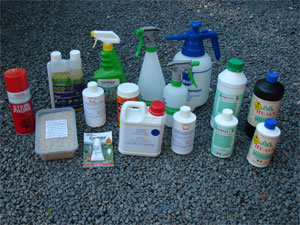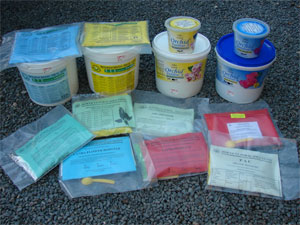What is Plant Nutrition
Plants use inorganic minerals for nutrition, whether grown in the field or in a container. Complex interactions involving weathering of rock minerals, decaying organic matter, animals, and microbes take place to form inorganic minerals in soil. Roots absorb mineral nutrients as ions in soil water. Many factors influence nutrient uptake for plants. Ions can be readily available to roots or could be "tied up" by other elements or the soil itself. Soil too high in pH (alkaline) or too low (acid) makes minerals unavailable to plants.
FERTILITY OR NUTRITION
The term "fertility" refers to the inherent capacity of a soil to supply nutrients to plants in adequate amounts and in suitable proportions. The term "nutrition" refers to the interrelated steps by which a living organism assimilates food and uses it for growth and replacement of tissue. Previously, plant growth was thought of in terms of soil fertility or how much fertiliser should be added to increase soil levels of mineral elements. Most fertilisers were formulated to account for deficiencies of mineral elements in the soil. The use of soil-less mixes and increased research in nutrient cultures and hydroponics as well as advances in plant tissue analysis have led to a broader understanding of plant nutrition. Plant nutrition is a term that takes into account the interrelationships of mineral elements in the soil or soil-less solution as well as their role in plant growth. This interrelationship involves a complex balance of mineral elements essential and
WHAT ARE THE MINERAL ELEMENTS?
There are actually 20 mineral elements necessary or beneficial for plant growth. Carbon (C), hydrogen (H), and oxygen (O) are supplied by air and water. The six macronutrients, nitrogen (N), phosphorus (P), potassium (K), calcium (Ca), magnesium (Mg), and sulfur (S) are required by plants in large amounts. The rest of the elements are required in trace amounts (micronutrients). Essential trace elements include boron (B), chlorine (Cl), copper (Cu), iron (Fe), manganese (Mn), sodium (Na), zinc (Zn), molybdenum (Mo), and nickel (Ni). Beneficial mineral elements include silicon (Si) and cobalt (Co). The beneficial elements have not been deemed essential for all plants but may be essential for some. The distinction between beneficial and essential is often difficult in the case of some trace elements. Cobalt for instance is essential for nitrogen fixation in legumes. It may also inhibit ethylene formation (Samimy, 1978) and extend the life of cut roses (Venkatarayappa et al., 1980). Silicon, deposited in cell walls, has been found to improve heat and drought tolerance and increase resistance to insects and fungal infections. Silicon, acting as a beneficial element, can help compensate for toxic levels of manganese, iron, phosphorus and aluminium as well as zinc deficiency. A more holistic approach to plant nutrition would not be limited to nutrients essential to survival but would include mineral elements at levels beneficial for optimum growth. With developments in analytical chemistry and the ability to eliminate contaminants in nutrient cultures, the list of essential elements may well increase in the future.
THE MINERAL ELEMENTS IN PLANT PRODUCTION
The use of soil for greenhouse production before the 1960s was common. Today a few growers still use soil in their mixes. The bulk of production is in soil-less mixes. Soil-less mixes must provide support, aeration, nutrient and moisture retention just as soils do, but the addition of fertilisers or nutrients are different. Many soil-less mixes have calcium, magnesium, phosphorus, sulfur, nitrogen, potassium and some micronutrients incorporated as a pre-plant fertiliser. Nitrogen and potassium still must be applied to the crop during production. Difficulty in blending a homogenous mix using pre-plant fertilisers may often result in uneven crops and possible toxic or deficient levels of nutrients. Soil-less mixes that require addition of micro and macronutrients applied as liquid throughout the growth of the crop, may actually give the grower more control of his crop. To achieve optimum production, the grower can adjust nutrient levels to compensate for other environmental factors during the growing season. The absorption of mineral ions is dependent on a number of factors in addition to weather conditions. These include the cation exchange capacity or CEC and the pH or relative amount of hydrogen (H+) or hydroxyl ions (OH-) of the growing medium, and the total alkalinity of the irrigation water.
pH: WHAT DOES IT MEAN?
The term pH refers to the alkalinity or acidity of a growing media water solution. This solution consists of mineral elements dissolved in ionic form in water. The reaction of this solution whether it is acid, neutral or alkaline will have a marked effect on the availability of mineral elements to plant roots. When there is a greater amount of hydrogen H+ ions the solution will be acid (<7.0). If there is more hydroxyl OH- ions the solution will be alkaline (>7.0). A balance of hydrogen to hydroxyl ions yields a pH neutral soil (=7.0). The range for most crops is 5.5 to 6.2 or slightly acidic. This creates the greatest average level for availability for all essential plant nutrients. Extreme fluctuations of higher or lower pH can cause deficiency or toxicity of nutrients.
THE ELEMENTS OF COMPLETE PLANT NUTRITION
The following is a brief guideline of the role of essential and beneficial mineral nutrients that are crucial for growth. Eliminate any one of these elements, and plants will display abnormalities of growth, deficiency symptoms, or may not reproduce normally.
MACRONUTRIENTS
Nitrogen is a major component of proteins, hormones, chlorophyll, vitamins and enzymes essential for plant life. Nitrogen metabolism is a major factor in stem and leaf growth (vegetative growth). Too much can delay flowering and fruiting. Deficiencies can reduce yields, cause yellowing of the leaves and stunt growth.
Phosphorus is necessary for seed germination, photosynthesis, protein formation and almost all aspects of growth and metabolism in plants. It is essential for flower and fruit formation. Low pH (<4) results in phosphate being chemically locked up in organic soils. Deficiency symptoms are purple stems and leaves; maturity and growth are retarded. Yields of fruit and flowers are poor. Premature drop of fruits and flowers may often occur. Phosphorus must be applied close to the plant's roots in order for the plant to utilise it. Large applications of phosphorus without adequate levels of zinc can cause a zinc deficiency.
Potassium is necessary for formation of sugars, starches, carbohydrates, protein synthesis and cell division in roots and other parts of the plant. It helps to adjust water balance, improves stem rigidity and cold hardiness, enhances flavour and colour on fruit and vegetable crops, increases the oil content of fruits and is important for leafy crops. Deficiencies result in low yields, mottled, spotted or curled leaves, scorched or burned look to leaves..
Sulfur is a structural component of amino acids, proteins, vitamins and enzymes and is essential to produce chlorophyll. It imparts flavour to many vegetables. Deficiencies show as light green leaves. Sulfur is readily lost by leaching from soils and should be applied with a nutrient formula. Some water supplies may contain Sulfur.
Magnesium is a critical structural component of the chlorophyll molecule and is necessary for functioning of plant enzymes to produce carbohydrates, sugars and fats. It is used for fruit and nut formation and essential for germination of seeds. Deficient plants appear chlorotic, show yellowing between veins of older leaves; leaves may droop. Magnesium is leached by watering and must be supplied when feeding. It can be applied as a foliar spray to correct deficiencies.
Calcium activates enzymes, is a structural component of cell walls, influences water movement in cells and is necessary for cell growth and division. Some plants must have calcium to take up nitrogen and other minerals. Calcium is easily leached. Calcium, once deposited in plant tissue, is immobile (non-Tran locatable) so there must be a constant supply for growth. Deficiency causes stunting of new growth in stems, flowers and roots. Symptoms range from distorted new growth to black spots on leaves and fruit. Yellow leaf margins may also appear.
MICRONUTRIENTS
Iron is necessary for many enzyme functions and as a catalyst for the synthesis of chlorophyll. It is essential for the young growing parts of plants. Deficiencies are pale leaf colour of young leaves followed by yellowing of leaves and large veins. Iron is lost by leaching and is held in the lower portions of the soil structure. Under conditions of high pH (alkaline) iron is rendered unavailable to plants. When soils are alkaline, iron may be abundant but unavailable. Applications of an acid nutrient formula containing iron chelates, held in soluble form, should correct the problem.
Manganese is involved in enzyme activity for photosynthesis, respiration, and nitrogen metabolism. Deficiency in young leaves may show a network of green veins on a light green background similar to an iron deficiency. In the advanced stages the light green parts become white, and leaves are shed. Brownish, black, or greyish spots may appear next to the veins. In neutral or alkaline soils plants often show deficiency symptoms. In highly acid soils, manganese may be available to the extent that it results in toxicity.
Boron is necessary for cell wall formation, membrane integrity, calcium uptake and may aid in the translocation of sugars. Boron affects at least 16 functions in plants. These functions include flowering, pollen germination, fruiting, cell division, water relationships and the movement of hormones. Boron must be available throughout the life of the plant. It is not translocated and is easily leached from soils. Deficiencies kill terminal buds leaving a rosette effect on the plant. Leaves are thick, curled and brittle. Fruits, tubers and roots are discoloured, cracked and flecked with brown spots.
Zinc is a component of enzymes or a functional cofactor of a large number of enzymes including auxins (plant growth hormones). It is essential to carbohydrate metabolism, protein synthesis and internodal elongation (stem growth). Deficient plants have mottled leaves with irregular chlorotic areas. Zinc deficiency leads to iron deficiency causing similar symptoms. Deficiency occurs on eroded soils and is least available at a pH range of 5.5 - 7.0. Lowering the pH can render zinc more available to the point of toxicity.
Copper is concentrated in roots of plants and plays a part in nitrogen metabolism. It is a component of several enzymes and may be part of the enzyme systems that use carbohydrates and proteins. Deficiencies cause die back of the shoot tips, and terminal leaves develop brown spots. Copper is bound tightly in organic matter and may be deficient in highly organic soils. It is not readily lost from soil but may often be unavailable. Too much copper can cause toxicity.
Molybdenum is a structural component of the enzyme that reduces nitrates to ammonia. Without it, the synthesis of proteins is blocked and plant growth ceases. Root nodule (nitrogen fixing) bacteria also require it. Seeds may not form completely, and nitrogen deficiency may occur if plants are lacking molybdenum. Deficiency signs are pale green leaves with rolled or cupped margins.
Chlorine is involved in osmosis (movement of water or solutes in cells), the ionic balance necessary for plants to take up mineral elements and in photosynthesis. Deficiency symptoms include wilting, stubby roots, chlorosis (yellowing) and bronzing. Odours in some plants may be decreased. Chloride, the ionic form of chlorine used by plants, is usually found in soluble forms and is lost by leaching. Some plants may show signs of toxicity if levels are too high.
Nickel has just recently won the status as an essential trace element for plants according to the Agricultural Research Service Plant, Soil and Nutrition Laboratory in Ithaca, NY. It is required for the enzyme urease to break down urea to liberate the nitrogen into a useable form for plants. Nickel is required for iron absorption. Seeds need nickel in order to germinate. Plants grown without additional nickel will gradually reach a deficient level at about the time they mature and begin reproductive growth. If nickel is deficient plants may fail to produce viable seeds.
Sodium is involved in osmotic (water movement) and ionic balance in plants.
Cobalt is required for nitrogen fixation in legumes and in root nodules of non-legumes. The demand for cobalt is much higher for nitrogen fixation than for ammonium nutrition. Deficient levels could result in nitrogen deficiency symptoms.
Silicon is found as a component of cell walls. Plants with supplies of soluble silicon produce stronger, tougher cell walls making them a mechanical barrier to piercing and sucking insects. This significantly enhances plant heat and drought tolerance. Foliar sprays of silicon have also shown benefits reducing populations of aphids on field crops. Tests have also found that silicon can be deposited by the plants at the site of infection by fungus to combat the penetration of the cell walls by the attacking fungus. Improved leaf erectness, stem strength and prevention or depression of iron and manganese toxicity have all been noted as effects from silicon. Silicon has not been determined essential for all plants but may be beneficial for many.
Your claim to Fame is a Fame Orchid
 |
 |













